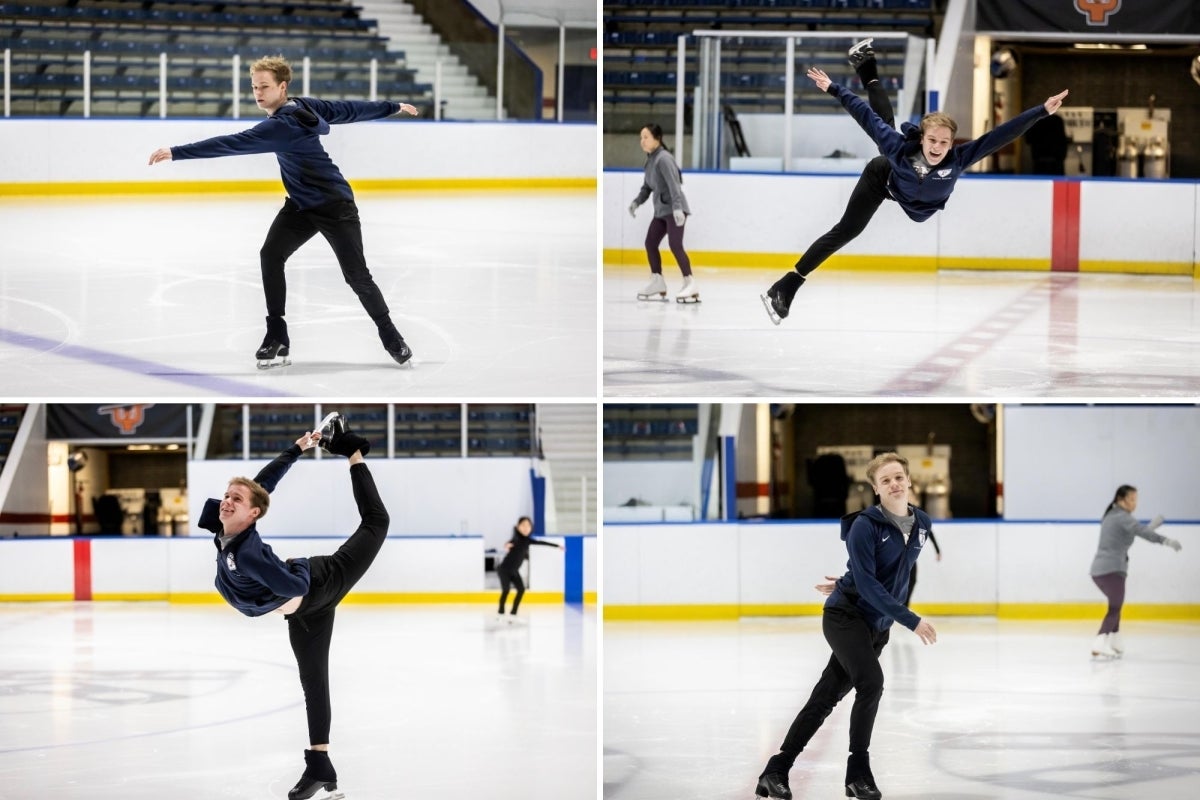Melding Loves of Ice Skating and Children’s Media
Fourth-year communication student Nick Bausenwein took two gap years to skate professionally with a touring show, competed with the Penn Figure Skating Club, and wrote a thesis on children’s perceptions of film character meet-and-greets.

Nick Bausenwein (All photos: Eric Sucar)
Nick Bausenwein recalls watching the Disney Channel original movie “Ice Princess” as a child growing up in Eatontown, New Jersey, and begging his parents to take him to the ice rink. Little did this 8-year-old know that this would lead to traveling the country as a professional ice skater, competing with and leading the Penn Figure Skating Club with co-president Emily Zhang, and developing an academic passion for children’s media and entertainment.
“I just completely feel like I’m out of this world when I’m on the ice, and I also just love the blend of athleticism and artistry,” says Bausenwein, now a fourth-year communication major minoring in consumer psychology and English. “Ever since I started my professional career, I connected with the storytelling aspect of figure skating and the performance and losing myself in whatever character I’m portraying.”
His professional career—with a touring ice show—started in the gap year Bausenwein took after high school. Two weeks after graduating, he was on a plane to Mexico, where he had five days of rehearsals and six weeks of shows before traveling along the West Coast from summer 2019 to March 2020.
“I had signed on for another year, then COVID happened, and obviously no shows were happening, so I emailed admissions, and I was like, ‘Wait, please let me back,’” he says with a laugh. Penn did, and he started college with virtual classes that fall, while also working as a scare actor at a theme park—an experience he wrote about while taking a writing seminar on Disney’s Middle Ages.
The following semester, Bausenwein returned to tour while taking a full course load of asynchronous classes. “I’d be on Zooms in the American Airlines Center in Dallas with a huge arena behind me, which was interesting. It was a lot, but it was great,” he says. Bausenwein then took another gap year to tour before returning to Penn.
Meet and Greets
Through the Annenberg in Public Service program, Bausenwein did an internship at PBS—working with kids’ content, seeing the research that goes into it, and learning how PBS measures programming to ensure it is helping kids.
Bausenwein plans to skate professionally for a bit longer after graduation but then wants to work in children’s media. He says the internship “gave me a lot of hands-on experience with exactly what I want to do. It was such a dream come true.”
This year, Bausenwein wrote an honors thesis titled “The Princess and the Perception of Reality: The Role of Film Character Meet and Greets in Children’s Fantasy/Reality Distinctions and Parasocial Relationships.”

He recalls feeling confused meeting Aurora at Disney World as a child because he thought she would be two-dimensional, which led him to have a lot of questions regarding what kids today think: “What are kids’ relationships to these characters, and what does that look like when they’re not just seeing the character on media but they’re actually getting to meet them in person, and how does that change their perception of reality about their character?”
Bausenwein tackled these questions for his thesis by interviewing 12 children at a Philadelphia youth organization—one group after just watching a movie and another group after both the movie and a meet-and-greet with someone portraying a character from the film.
“I found that while there was not a clear effect on children’s fantasy/reality distinctions, the interactions seemed to change the way kids think about the character they met,” he says. “The meet-and-greet was an important piece of evidence they used in making these judgments. Though the sample was small, my findings also suggest the meet-and-greets could play a role in parasocial relationships.”
Giving Kids Quality Content
When Bausenwein was touring, he helped with publicity—doing interviews and designing TikTok templates. He thought he might be interested in pursuing a career in marketing and public relations. But taking Annenberg School for Communication senior lecturer and advisor Kim Woolf’s Children and Media course proved a turning point in the narrative arc of his life.
“I got introduced to a lot of the opportunities that exist within children’s media development, some on the creative side and some on the research side, seeing how kids learn,” he says. “I saw the impact that quality kids’ media can have and how important it is.”
Growing up, Bausenwein says, “Media and characters were such an important part of my life.” He loved Peter Pan, Buzz Lightyear, and the Disney princesses, especially Belle. He loved going to see Disney on Ice and Stars on Ice, and he loved going to theme parks.
“All of us remember our favorite characters from when we were growing up really fondly and the fun memories we had with that, but there’s so much that we learn from the characters,” he says. “I think it’s really important to make sure we’re giving kids good content—to make sure we’re giving kids content that represents the world around them and also the world not around them. There’s so much that it does for equity and education and making sure that kids all get an equal chance no matter where they come from.”



